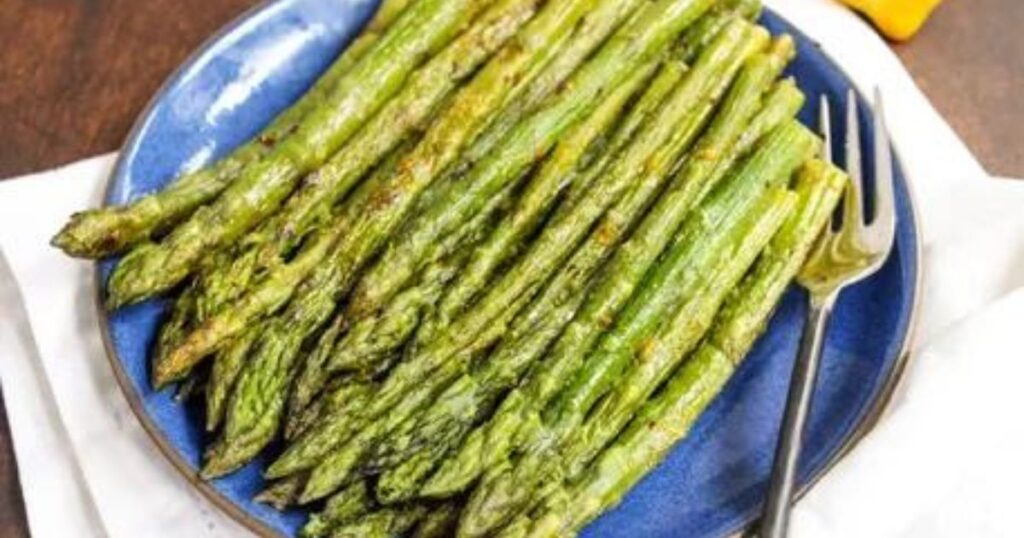To cook frozen asparagus, start by thawing it in the refrigerator or under cold running water. Once thawed, simply sauté it with olive oil, garlic, and a pinch of salt for a flavorful side dish. Alternatively, you can roast it in the oven with a drizzle of olive oil and your favourite seasonings until tender.
How To Cook Frozen Asparagus? Unlock the secrets with a simple technique. Just thaw, season, and roast for a burst of flavour in every bite. Curious to elevate your culinary skills effortlessly Let’s embark on this flavorful journey together. Ready to savour the deliciousness.
To cook frozen asparagus, start by preheating your oven to 400°F (200°C). Spread the frozens asparagus evenly on a baking sheet. Drizzle olive oil over the asparagus and sprinkle with salt and pepper to taste. Roast in the oven for 15-20 minutes until tender, flipping halfway through. Serve hot as a delicious and nutritious side dish.
Selecting Quality Frozen Asparagus
Selecting high-quality frozen asparagus is the crucial first step in ensuring a flavorful culinary experience. When perusing the frozen food aisle, opt for packages that feature whole spears or neatly cut pieces, avoiding any that show signs of discoloration or freezer burn. Vibrant green hues and firm textures are indicators of freshness and quality. Additionally, inspect the packaging for any signs of damage or frost accumulation, as these can suggest improper storage or handling. Opt for reputable brands known for their commitment to quality and freshness, and check the expiration date to ensure optimal flavor and nutritional value.
Once you’ve selected your frozen asparagus, it’s essential to handle it properly to maintain its quality. Transport it home promptly and store it in the freezer at or below 0°F (-18°C) to prevent thawing and freezer burn. Proper storage and handling from the store to your kitchen ensure that your frozen asparagus retains its delicious flavor and nutrients, ready to be transformed into a delightful culinary masterpiece.
Thawing Properly

Thawing frozen asparagus properly is crucial to ensure that it cooks evenly and retains its optimal texture and flavour. There are a few recommended methods for thawing frozen asparagus. One option is to transfer the sealed package of frozens asparagus to the refrigerator and allow it to thaw overnight. This method provides a gradual thaw, minimising the risk of bacterial growth while preserving the asparagus’s quality.
Alternatively, if you need to thaw the asparagus more quickly, you can use a cold water bath. Simply submerge the sealed package of frozen asparagus in cold water, ensuring that it remains sealed to prevent water from seeping in. Replace the water every 30 minutes to maintain a consistent temperature until the asparagus is fully thawed.
It’s essential to avoid thawing frozens asparagus at room temperature, as this can promote bacterial growth and compromise food safety. Additionally, refrain from thawing frozen asparagus in hot water or the microwave, as these methods can lead to uneven thawing and potentially cook the outer layers of the asparagus, resulting in a less desirable texture. By following these proper thawing techniques, you can ensure that your frozen asparagus is thawed safely and ready to be transformed into a delicious culinary masterpiece.
Preparation and Seasoning:
Once thawed, pat the asparagus spears dry with paper towels to remove excess moisture. This step helps to achieve a better texture when cooking. Season the asparagus according to your taste preferences. Simple seasoning with olive oil, salt, and pepper works wonders, or you can experiment with herbs, garlic, lemon zest, or balsamic vinegar for added flavour complexity.
Cooking Methods
When it comes to cooking frozen asparagus, versatility is key. There are several cooking methods you can employ to bring out the best in this delightful vegetable. One popular method is roasting. Preheat your oven to 400°F (200°C), toss the thawed asparagus spears with olive oil, salt, and pepper, then spread them out in a single layer on a baking sheet. Roast for 15-20 minutes until the spears are tender yet still crisp, and slightly caramelised. This method enhances the natural sweetness of the asparagus while adding a hint of smokiness.
Another fantastic cooking method for frozen asparagus is steaming. This gentle cooking technique preserves the vibrant green colour and crisp texture of the spears. Simply place the thawed asparagus in a steamer basket over boiling water, cover, and steam for 5-7 minutes until they are crisp-tender. Avoid overcooking, as this can result in limp, mushy asparagus. Steamed frozen asparagus makes a perfect side dish for a variety of meals and allows the vegetable’s fresh flavour to shine through. Whether roasted to perfection or steamed to retain its crispness, frozen asparagus offers endless possibilities for delicious culinary creations.
Adding Finishing Touches
Adding finishing touches to your cooked frozen asparagus can elevate its presentation and flavour profile to new heights. Consider a sprinkle of freshly grated Parmesan cheese over the warm spears, allowing it to melt slightly and impart its rich, savoury notes. Alternatively, a generous handful of toasted almonds adds a delightful crunch and nuttiness, complementing the tender asparagus perfectly. For those craving a bit of texture contrast, a light dusting of seasoned breadcrumbs provides a subtle crispiness that enhances each bite.
To brighten up the dish and add a burst of acidity, a squeeze of fresh lemon juice or a drizzle of balsamic glaze can work wonders. The citrusy tang of lemon cuts through the richness, while the sweet and tangy notes of balsamic glaze add depth and complexity. Freshly chopped herbs such as parsley, dill, or chives can also lend a pop of colour and freshness, imparting a garden-fresh aroma that tantalises the senses. With these simple yet impactful finishing touches, your cooked frozen asparagus will not only taste delicious but also look visually stunning, making it a standout star on any dining table.
Storage and Leftovers
When it comes to storing leftovers of cooked frozen asparagus, proper handling is key to maintaining its flavour and texture. After enjoying your meal, promptly transfer any remaining asparagus to an airtight container or resealable bag. Ensure that it is cooled to room temperature before sealing to prevent condensation and potential moisture buildup. Stored this way, cooked asparagus can be refrigerated for up to three days. When reheating, it’s best to do so gently to preserve its delicate texture and flavour. Whether using the microwave or oven, reheating in short intervals and checking for desired warmth ensures that your leftover frozen asparagus maintains its quality.
If you find yourself with an excess of cooked frozen asparagus that you’re unable to consume within the recommended storage period, consider incorporating it into other dishes to minimise waste. Chopped asparagus makes a fantastic addition to frittatas, soups, or pasta dishes. Alternatively, pureeing cooked asparagus can result in a flavorful base for creamy sauces or dips. By repurposing leftovers creatively, you not only extend the lifespan of your frozen asparagus but also unlock new culinary possibilities, making every meal a delicious adventure.
Faqs
Can I cook frozen asparagus without thawing it first?
Yes, you can cook frozen asparagus without thawing it first. However, thawing it allows for more even cooking and better flavour absorption.
How long does it take to cook frozen asparagus?
Cooking times vary depending on the method used. Generally, it takes about 15-20 minutes to roast or grill, 5-7 minutes to steam, and 5-7 minutes to sauté frozen asparagus.
Can I refreeze cooked frozen asparagus?
It’s not recommended to refreeze previously frozen asparagus after it has been cooked, as this can affect its texture and taste.
How do I know when frozen asparagus is cooked?
Frozen asparagus is cooked when it is tender yet still crisp, and it has developed a vibrant green colour. Avoid overcooking, as this can result in mushy asparagus.
Can I season frozen asparagus before cooking?
Yes, seasoning frozen asparagus before cooking enhances its flavour. Common seasonings include olive oil, salt, pepper, garlic, lemon zest, herbs, or balsamic vinegar. Adjust seasoning according to your taste preferences.
Conclusion
In conclusion, mastering the art of cooking frozen asparagus opens up a world of culinary possibilities, offering convenience without sacrificing flavour or nutrition. By following simple steps such as proper thawing, seasoning, and cooking techniques, you can transform frozen asparagus into a versatile and delicious addition to any meal. Whether roasted, steamed, sautéed, or grilled, frozen asparagus retains its vibrant colour and distinctive taste, providing a burst of freshness to your dishes year-round.
With careful storage and creative use of leftovers, you can make the most out of this freezer staple, minimising waste and maximising culinary enjoyment. So, the next time you reach for that bag of frozen asparagus, embrace the opportunity to elevate your cooking and savour the flavours of this versatile vegetable.
click on this link to get more information “How To Cook Chuck Eye Steak?“


